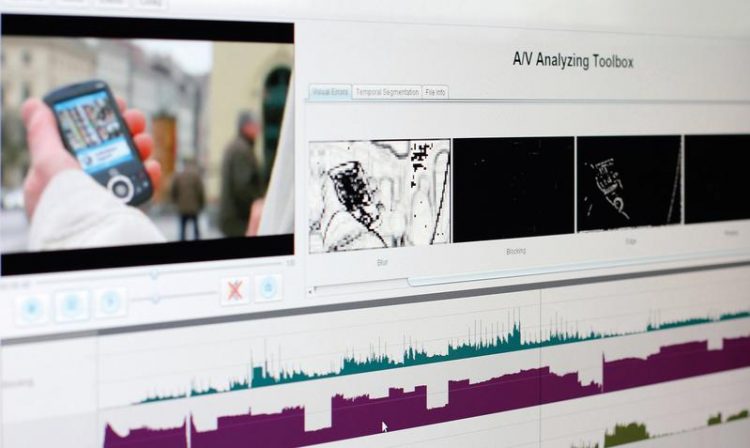A/V Analyzing Toolbox for Automatic Quality Control and Efficient Management of A/V Content

The A/V Analyzing Toolbox provides automatic detection of audio-visual errors on signal level. Fraunhofer IDMT
Assessing the quality of audio and video content
The software components for automatic quality control allow fast identification of quality problems in digital audio and video recordings. With the »Quick Scan« module large databases can be searched through very fast in order to detect typical errors, such as blocking, blurring, or ringing. In addition, the institute presents its improved analyzing method to proof the field order/field dominance for each video frame.
“Our tools for continuous quality control help film producers or broadcasters ensure that audio and video content is error-free already during the production process. Content can then be edited, distributed and archived more efficiently, as all related processes are automated”, says Dr. Uwe Kühhirt, head of the Audiovisual Systems group at Fraunhofer IDMT.
Detection of speech and music
The module for automatic speech/music discrimination allows determination of the amount of music, speech, speech together with background music, and silence in radio and TV programs. This can be used for automatic music royalty reporting, cue sheet generation, or content search.
Segment-based video identification
Using this module, it is possible to identify video segments that originate from the same recording or source. Dr. Uwe Kühhirt explains the principle of segment-based video identification: “With our method, compact representations, so-called fingerprints, are generated from the video material. These fingerprints can then be compared to each other in a multi-stage, automated process in order to find those segments in the video recording that originally come from a certain source.”
The method cannot only be used to determine if and where a video segment has been reused, but also how long this segment is and at which position within a longer se-quence it has been inserted. It is also possible to find out if content has been manipu-lated, how much of the content has been used, and where it has been reused.
The method for segment-based video identification has been developed in “CUbRIK”, a reseach and development project funded by the European Commission, where Fraunhofer IDMT is participating as a research partner. The aim of the project is to de-velop an intelligent framework for multimedia search that takes into account the knowledge and the skills of users to optimize the results of automated methods of analysis.
The A/V Analyzing Toolbox is completed by the module for Temporal Video Segmenta-tion, by which shots and representative key frames in movies can be identified in order to be able to search for and manage content more easily. Based on the information gained from this, e.g. rhythmical patterns in movies can be analyzed. Integrated motion analysis allows detection and classification of local and global motion in videos (e.g. pans, tilts, or zooms).
Feel free to stop by the Fraunhofer booth SU6117 in the South Upper Hall to get to know our broad range of audio/video analysis tools.
http://www.idmt.fraunhofer.de/avtoolbox – A/V Analyzing Toolbox
http://www.idmt.fraunhofer.de/qc – Quality Control
Media Contact
All latest news from the category: Trade Fair News
Newest articles

Properties of new materials for microchips
… can now be measured well. Reseachers of Delft University of Technology demonstrated measuring performance properties of ultrathin silicon membranes. Making ever smaller and more powerful chips requires new ultrathin…

Floating solar’s potential
… to support sustainable development by addressing climate, water, and energy goals holistically. A new study published this week in Nature Energy raises the potential for floating solar photovoltaics (FPV)…

Skyrmions move at record speeds
… a step towards the computing of the future. An international research team led by scientists from the CNRS1 has discovered that the magnetic nanobubbles2 known as skyrmions can be…





















